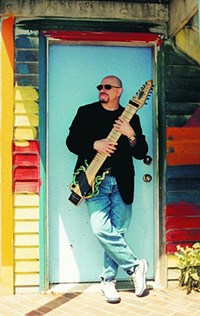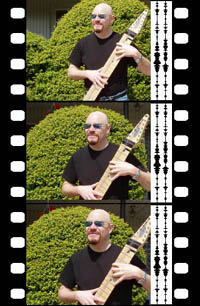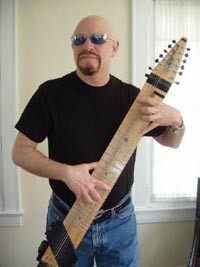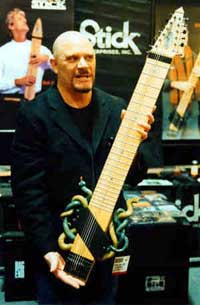
Essential Guitarist
OF: Steve, back in the seventies, you started your musical journey as a guitar player. You played with many great jazz musicians such as Tal Farlow, Joe Pass and John Scofield. What made you switch to the Chapman Stick sometime around 1984?
SA: My early experiences with the guitar were actually more in the fingerpicking styles of John Fahey, Leo Kottke, and Chet Atkins. I found this type of guitar style very fulfilling. Of course the times were great for guitar growth with all the new sonic explorations of the Woodstock generation musicians. Guitar based bands such as the Allman Brothers and Cream would record extended jams and the resulting music would be very inspiring. John Fahey was that sort of player on the solo acoustic guitar. You could hear him thinking and searching as a good jazzer might do.

Sometimes it worked, sometimes it didn’t. But the adventure was always there. That’s always been a part of my approach to music. My jazz guitar studies were at first, just a challenge, but the harmonic vocabulary just became so intriguing. I had the fortune to play with some great jazz guitar players as you mentioned. For two years I was the house guitar player at a club in NY called Peppers. Once or twice a week, I played with the best in town. Besides the guys you mentioned, there was Attilla Zoller, Jimmy Ponder, Jack Wilkins, Chuck Wayne and dozens of others who came by and sat in. That was my classroom, always absorbing knowledge from these great players. Then in 1983, there was this guitar expo in Madison Square Garden in NY. This was my first live encounter with the Chapman Stick. Emmett Chapman the inventor, was giving demonstrations on this amazing instrument. I was convinced, I had to get one. Well, Sam Ash music carried the Stick and I purchased my first Stick soon after (1984). I didn’t intend to switch over from guitar entirely. Just thought I’d experiment a bit. Well, little by little, I was playing less guitar and spending more time with the Stick. Now 19 years later, I perform only on the Chapman Stick. That initial spark of musical creativity that I experienced in the early seventies was the main thrust to pursue the infinite possibilities of this revolutionary instrument.
OF: Being a Guitarist, did that help you to master the Stick or did you have to restart everything from scratch?
SA: Well, my fingers had a head start from 15 years of fingerpicking and jazz playing. But the tuning and the tapping technique were different. So yes, it was like starting over. But it was so exciting that the learning curve was extremely accelerated. First it was finding the correct notes for scales and chords. Then it became discovering alternative ways to play these voicings and new fingerings. Two hands, ten fingers, ten strings, it was like a giant menu of possibilities. I still marvel at how much there is to learn from the Stick.
OF: The Stick has never managed to be a huge public success, even though it’s been around for almost 30 years. Do you think this has its roots in its hybrid nature? (It is often presented as a mix between a bass, a guitar and a keyboard)
SA: I don’t think that’s the case. The Stick has its own identity and there are many players defining its musical role. It’s not in every home for some simple reasons. It’s not like spending $175 for a beginner guitar. Although Stick Enterprises successfully keeps the cost down, the price tag is considerably more, so the investment is a consideration. They’re also not mass produced like a Fender or Gibson guitar. As far as musical recognition, that is changing everyday. Tony Levin plays the Stick in front tens of thousands of fans almost nightly. There are others getting needed exposure in smaller arenas all the time. There are TV appearances and many press articles about the Stick.The missing piece of the puzzle might be the high profile solo artist who features the Stick in his music. Someone like Pat Metheny or Allan Holdsworth. Both have some experience with the instrument. I think this mystery Stick instrumentalist will emerge in the very near future.
OF: You’ve been playing Stick for almost 20 years. Would you say that Stickists are more wanted in studios now?
SA: I still think the recording community is unaware of the musical possibilities of the Stick and what a player can bring to a project. CDs are strictly a listening experience, so the “look I can play two things at once” situation is unimportant. In the studio, parts are overdubbed, and sounds are sampled. Many parts are not even done in real time. I think what the producers are missing are the harmonic and rhythmic possibilities that a Stick player could contribute. Stick ideas can be quite unique. Of course Mr. Levin has played Stick on many CDs (and vinyls). Other players are starting to get calls as word gets out. I think the composers also are not familiar with the Stick’s capabilities and therefore might not know how to write parts for it. As more players get recognized, I think this will change. In the meantime more and more Stickists are doing their own projects.
OF: We don’t see too many Stickists in jazz groups, though it has great potential as you’ve proven with your art. How do you explain that?
SA: Two basic reasons for this situation. From my experiences, a large number of Stick players pursue the prog rock or New Age avenues. It’s jazz in that it may have improvisational and exploratory elements, but it’s not jazz in the pure sense. So in numbers, the pool of jazz Stick players is limited. Secondly, many traditional jazz groups are very conservative, contrary to the music’s real nature. They seem to shy away from anything that challenges tradition. How long did it take for electric basses to be accepted? Still aren’t in some jazz circles. Solid body guitars? What chance does a Chapman Stick have? On the flip side, to me that would be advantageous. Jazz is supposed to look ahead and be a creative entity. Why not use all the new tools available? The Stick is foremost an incredibly inspirational instrument. I have found players who share these ideas and that’s a good reason why I’m so satisfied with our band chemistry.
OF: You’ve played with Stanley Jordan, known for his Two handed tapping, which looks incredibly like a Stick technique. Have you experimented and tried to apply this amazing technique back on guitar?
SA: What makes Stanley a great player is that above all he’s a wonderful musician. A great technician, yes, but more importantly an expressive artist. The Stick technique is a bit different in that the hands are held at a different angle and of course there are more strings. Early on before I owned a Stick I experimented with tapping on a guitar. But once I began playing the Stick there was no turning back. Ergonomically, it feels right. It offers me more possibilities in every way. So, no I don’t go back and tap on the guitar. Actually last gig I did with Stanley, he played my Stick for a while and of course came up with some great musical ideas.
OF: How do you see the success of fellow Stickist Tony Levin on the pop-rock scene with Peter Gabriel and King Crimson? Would you be tempted as a part-time job to join a successful rock band like King Crimson for instance?
SA: Tony’s success is wonderful. He’s very popular in the bass and Stick community and not just for his musical contributions. He’s very giving of his time and has been very influential to players internationally. I was honored when he agreed to play a tune on my last CD. And of course, when Tony plays Stick in front of 20,000 people a night it’s great exposure for the instrument. As far as being tempted to play in a rock band, if Robert Fripp asks you, tell him I’m available. My tastes are not stuck in the jazz idiom. When I perform, my repertoire includes covers of Led Zeppelin, Pink Floyd, the Police and whatever I like. Don’t forget, I experienced the 60”s rock revolution and absorbed all that music. Before I heard of Wes Montgomery, I listened to Frank Zappa and Procol Harum and such. So that music is far from alien to me. I love playing jazzy versions of those rock tunes. David Gilmour, give me a call.

OF: What are your sources of inspiration?
SA: The most inspiring thing right now is the Stick itself. The endless possibilities for musical expression is just plain awesome. The combination of the two handed tap technique and the ingenious tuning that Emmett discovered, have become an open door for me to a new creative world. I’m constantly amazed at the amount of ideas that I find whenever I pick up the instrument. Musically, certain musicians always influenced, my style. Wes Montgomery of course. His solos are polished jewels. And Pat Metheny as a player and more importantly as composer and arranger. He doesn’t write ditties. He truly composes. And there are no limitations in what he puts out to the listener. His music runs the full spectrum from gorgeous duets and smoking group sessions to confrontational sonic blasting. I had the unique pleasure of playing music with Pat for a brief time before his last group tour. Now that was inspiring. Other guitarists who have penetrated my inner being are Michael Hedges, Stanley Jordan, Ralph Towner, Django Reinhardt, Allan Holdsworth and maybe a thousand other guys. I also listen to tons of piano players like Chick Corea, Herbie Hancock, McCoy Tyner, and on and on. All good players contribute something to the musical landscape. Digesting their art and making it part of yours is tricky but so rewarding. I can’t forget the inspiration I get from playing with my bandmates who are truly great musicians. Bryan Carrott (vibes) just knocks me out every time I hear him. He contributes so much to our band sound. And Nydia “Liberty” Mata our percussionist is swingin’ and above all a very sensitive player. They both live by the same motto, and team concept, that it’s all about the music, the sincerity and the quality. But always making it creative and fun.
OF: What musicians that you haven’t played with yet, would you like get together with?
SA: Wow, there are so many. I would love to do a duo CD with myself on Stick and some of my favorite guitarists. I’ve played briefly with both Pat Metheny and Pat Martino, and they would be high on the list for duos. And of course Holdsworth, Ralph Towner and George Benson.Then there’s Satriani and Vai. I could go on forever with this one. How about Bela Fleck, Chick Corea, and Elvin Jones. Jeff Beck, Jack DeJohnette and Michael Brecker? Enough? I always enjoyed playing with great players because it naturally forces me to be more creative and focused. What better way to elevate your art.
OF: Can you tell us about your gear set up?
SA: Well right now I have four Chapman Sticks, each with different electronics. Two of them have the Roland GK MIDI pickup which was specially designed for the string spacing of the Stick. I play these through the Roland GR30 or GR33 which are the MIDI sound sources. You can hear them throughout the last CD but in full force on the tune “The Answer Is Free” The first 1 1/2 minutes is all Stick and drums and most listeners don’t know that. My primary processor is the VG88 (Roland) which allows me to get a variety of guitar type simulations. I think I’ve gotten a very realistic jazz box sound, which was one goal on the recording. The Stick is stereo, so I usually play through two amps. I use Roland’s JC120 for the treble side (you would think I should have a Roland endorsement? No!). For the bass strings I play through either an SWR Working Man 15 or a Gallien- Krueger 1001 RB combo. I don’t like to over process my sound, but I do try to just sound fuller. The search for better gear is never ending, but always fun (and expensive).
OF: How do you record your Stick? How does it blend in the mix compared to a regular jazz guitar?
SA: Well on this last recording, I used nine tracks for the Stick alone. There was dry, processed, stereo processed, miked, MIDI and who even remembers. When we went to mix, I pulled up the tracks that sounded best for each tune. Each had a different timbre, dynamic and eq. Without changing the board much, we had a lot of sounds to choose from. We played in real time with no overdubs, so it was like doing a gig. I wanted that spontaneous sound. I think if you polish creative music artificially, it sucks the life out of the music. All the musicians at the date felt the chemistry that weekend was just phenomenal. Everything just clicked. I think you can hear the joyous result.
OF: What one big tip would you give to a Stick apprentice?
SA: That learning the Stick is a marvelous adventure. With a small amount of intuition and dexterity, musical ideas will just flow. The discipline to learn the Stick is no different than any other instrument. I guess because it’s not mainstream, beginners are intimidated. Quite the contrary. I truly believe, the Stick is a very easy instrument to learn. And the results are mind blowing.

OF: Your CD “The Answer’s Inside” covers a lot of different jazz styles (free, latin, cool, Wes influences, etc.) but it remains remarkably coherent at the same time. You avoid the “Stick demo album” and the whole band is very tight and inspired. Can you elaborate on this?
SA: First of all the musicians who contributed all played brilliantly. There were no band rehearsals. We briefly went over each tune in the studio and went for it. I wanted to keep that fresh and spontaneous flavor. I knew the musicians would nail it. What was probably unexpected was the chemistry and intuition of all involved. It was very magical. It just seemed like each phrase or new idea was anticipated by everyone and we all played on the same creative wave length. Even the engineer was amazed. Each tune had different personnel but the results were similar. As far as the different styles, I wanted to showcase a variety of themes and instrumentations to keep the music more entertaining. I think when a recording is one sonic statement for an hour it gets very tiresome. And the bottom line was making good music. Although the Stick technique is visually eye catching, a CD is a listening experience and that must be made primary. So in a way, it isn’t a Stick album per se but the Stick is central to all the music. The song sequence on the CD also seems to unfold like a movie and has development and dynamics. And some humor. Remember, music is fun, even jazz.
OF: Your use of MIDI Stick is hard to tell for the listener. Can you explain?
SA: Most of the time I used actual MIDI samples sparingly. On the third tune “The Answer Is Free” I use it primarily. The sound that opens the track, is mistaken for processed vibraphone and then an electronic keyboard. That’s all MIDI Stick. At the end I used a solo voice similar to the synth sound of Pat Metheny. The solo ideas are so different when playing like this. At other times the MIDI sounds are just colorations. Again the emphasis was not on showcasing the synth, but to make band music. The whole is bigger than the parts. So if it blended well, I achieved my goal in that respect. Playing with MIDI sounds is lots of fun but over use can be destructive. I look at MIDI as another tool, not THE tool.
OF: How did you get Larry Coryell on board?
SA: I’ve known Larry for many years and we’ve played together at shows from time to time. He was in town (NY) when we were going into the studio. I called him and asked if he would contribute his talents, and next thing I knew he was behind the glass. He didn’t have much time so he was only on one tune, but that tune came in at 14 minutes. Thanks Larry.
OF: There is a special duet with Tony Levin. This piece sounds very much as if it was composed originally by T.L. himself but it wasn’t. How did you work together on this piece?
SA: When I approached Tony for the CD, he invited me up to Woodstock to play at Jerry Marrota’s studio in a trio setting with Jerry on drums. I only came with a sketchy chord progression and some orchestration ideas. So we all had input on where this was going to go. Tony’s style is absolutely very evident on this piece (“Woodstick Suite”). Same holds true for Tony’s influence on King Crimson. He is a very large part of creating that sound. He doesn’t just play parts, he puts a personal stamp on the music, so it will naturally sound like a Tony tune. This composition might have been the most collaborative on the CD. It was tough coordinating two Chapman Sticks, playing 24 strings in total, and dancing in and out of each others sonic turf. It was very unique. I’d like to try more of this in the future.
OF: “The Answer’s Inside” is almost two years old now. Can you tell us about your upcoming projects?
SA: I’ve been doing a lot of teaching and gigging, but not much studio work. I think it might be time for that duo CD and maybe even a solo project, where the Stick will be front and center. I hope to do more jazz festivals this year. Where the musical journey goes from there is a guess. But that’s part of the fun, isn’t it?
